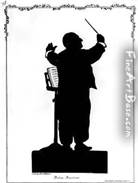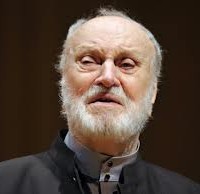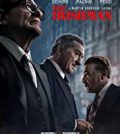- Two Thanksgiving Thoughts for the ACAPosted 10 years ago
- Shop til you Drop at the Healthcare Marketplace Part 2: Frustration!Posted 10 years ago
- An Early Casualty in the Affordable Care FightPosted 10 years ago
- Some Good News for a ChangePosted 10 years ago
Four Last Songs by Curtis Rittenhouse
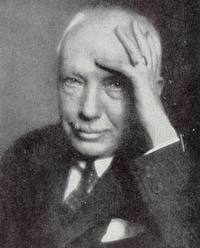
 One of the most remarkable compositions of the Twentieth Century is Richard Strauss’s Four Last Songs, written when the composer was in his 80’s. I have been listening to the versions in my collection recently because for some reason the moment has re-connected me to this greatly moving music.
One of the most remarkable compositions of the Twentieth Century is Richard Strauss’s Four Last Songs, written when the composer was in his 80’s. I have been listening to the versions in my collection recently because for some reason the moment has re-connected me to this greatly moving music.
Strauss was both shattered and disillusioned by what he had experienced in Germany under the Nazis. He was criticized for remaining and cooperating in any way with Hitler’s regime who admired him but did not trust him. He spent the war trying to protect his Jewish relatives from political machinations, especially his daughter-in-law’s family and his grandchildren. The devastating bombings of the great cities affected him deeply. In the end he took his family to Vienna and later to Switzerland, though eventually they returned. He understood immediately that an older order which he treasured, a Romanticized and humanistic German culture and artistic life, had been annihilated and would never return.
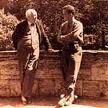 The devastation in Munich inspired his late masterpiece Metamorphosen. But his composition had slowed. Inspiration flagged. Then in 1945 an US serviceman and member of the Pittsburgh Symphony recognized him during the liberation of Germany and inspired him to write his Oboe Concerto. Though the commanding technique of his earlier works remained, the brash, confident mood of his earlier masterpieces was giving way to a gentler more nostalgic voice.
The devastation in Munich inspired his late masterpiece Metamorphosen. But his composition had slowed. Inspiration flagged. Then in 1945 an US serviceman and member of the Pittsburgh Symphony recognized him during the liberation of Germany and inspired him to write his Oboe Concerto. Though the commanding technique of his earlier works remained, the brash, confident mood of his earlier masterpieces was giving way to a gentler more nostalgic voice.
He returned to writing songs for the soprano voice, now with a wistful, autumnal glow. One poem by Joseph von Eichendorff about the end of life caught his imagination. Soon there were four of them, three to texts by Hermann Hesse. There is no indication Strauss himself saw them all as a unit, but his publisher did. A posthumous debut was arranged with Kirsten Flagstad, the dedicatee of the Hesse songs, and Wilhelm Furtwangler conducting in London.
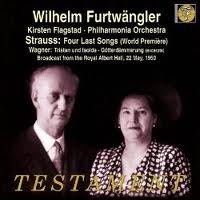 Disagreement about the exact order of the pieces was a matter of discussion. There was no disagreement that here was a final masterpiece. Unlike so much mid-twentieth Century Music, it entered the repertoire immediately. Vier Letzte Lieder have been recorded many times now, and I have collected some of the best versions. They fall into three categories: the dramatic, the expressive and the lyric. As with all groupings, the lines blur
Disagreement about the exact order of the pieces was a matter of discussion. There was no disagreement that here was a final masterpiece. Unlike so much mid-twentieth Century Music, it entered the repertoire immediately. Vier Letzte Lieder have been recorded many times now, and I have collected some of the best versions. They fall into three categories: the dramatic, the expressive and the lyric. As with all groupings, the lines blur
The Flagstad version definitely falls into the dramatic category. She was the great Wagnerian singer of the Twentieth Century. Furtwangler was the great German conductor of all time. This is the documentation of a live concert on May 22, 1950 so much consideration has to be given to tone, perspective and audience noise. I am glad we at last have official access to this important historical record, but it is not my favorite. These great artists are feeling their way into new territory. They do a wonderful job, but we now have the benefit of much reflection on this work. Birgit Nilsson’s version which I have heard but don’t own is similar. Jessye Norman the possessor of a similar big dramatic soprano presence does a very good job of scaling everything down to the mood of each song, considerably aided by Kurt Masur and the Leipzig Gewandhaus. A remarkable job of voice control and one version to hear.
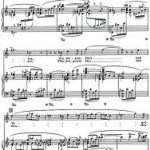 Renee Fleming in her two interpretations, one with Eschenbach in Houston, the other Theilemann in Munich places admirable emphasis on putting across the meaning of the words. The trouble is that putting meaning across can get in the way of the beauty of Strauss’s careful orchestration. Elizabeth Schwarzkopf, perhaps the most celebrated interpreter of this music does a very good job of resolving the dichotomy between meaning and mood. Her earlier mono version with Otto Ackermann in London is justly praised. Her later stereo remake with Szell in Berlin heads many favorite lists. There are two live performances with Karajan and Szell. Both require tolerance with the vagaries of non-commercial recording. Like the Norman/Masur these are slower and thoughtful interpretations.
Renee Fleming in her two interpretations, one with Eschenbach in Houston, the other Theilemann in Munich places admirable emphasis on putting across the meaning of the words. The trouble is that putting meaning across can get in the way of the beauty of Strauss’s careful orchestration. Elizabeth Schwarzkopf, perhaps the most celebrated interpreter of this music does a very good job of resolving the dichotomy between meaning and mood. Her earlier mono version with Otto Ackermann in London is justly praised. Her later stereo remake with Szell in Berlin heads many favorite lists. There are two live performances with Karajan and Szell. Both require tolerance with the vagaries of non-commercial recording. Like the Norman/Masur these are slower and thoughtful interpretations.
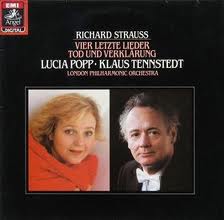 Lisa Della Casa, who made the first commercial version in Vienna with Karl Bohm moves us closer to the third group. This combination of artists certainly has the proper Strauss credentials. They let the music flow more freely, and let the words speak for themselves. The result is quite impressive and well worth hearing. Which brings me to my favorite interpretation, Lucia Popp and Klaus Tennstedt with the London Philharmonic. Here is a smaller sweeter voice than heard above, and one that seems completely in tune with what the composer wrote. There are great moments of gentle beauty sung with a natural flow that carries you along. I have heard a recording of the version she did live in Los Angeles under Giulini which is similar. A performance in Chicago with Solti is also available to watch, but he pushes more aggressively like this was early Strauss. With Klaus Tennstedt and the benefit of a recording studio, everything seems just perfect and no allowances need be made.
Lisa Della Casa, who made the first commercial version in Vienna with Karl Bohm moves us closer to the third group. This combination of artists certainly has the proper Strauss credentials. They let the music flow more freely, and let the words speak for themselves. The result is quite impressive and well worth hearing. Which brings me to my favorite interpretation, Lucia Popp and Klaus Tennstedt with the London Philharmonic. Here is a smaller sweeter voice than heard above, and one that seems completely in tune with what the composer wrote. There are great moments of gentle beauty sung with a natural flow that carries you along. I have heard a recording of the version she did live in Los Angeles under Giulini which is similar. A performance in Chicago with Solti is also available to watch, but he pushes more aggressively like this was early Strauss. With Klaus Tennstedt and the benefit of a recording studio, everything seems just perfect and no allowances need be made.
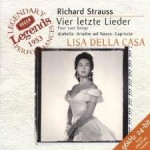 There are other versions, I will not claim to have heard them all: Arleen Auger with Previn, Teresa Stich Randall live with Ansermet, Christine Brewer with Runnicles, Jane Eaglen with Runnicles, Gundula Janowitz with Karajan (greatly admired, lyric and careful), Heather Harper with Hickox, Kiri Te Kanawa with Andrew Davis, (very much in the Popp league), Marton with the same Davis, Elisabeth Soderstrom with Richard Armstrong, Leontyne Price with Leinsdorf….. The list is exhaustive and still growing. Try one of these and see if you don’t agree: Four Last Songs is great music that really demands to be heard and absorbed and remembered.
There are other versions, I will not claim to have heard them all: Arleen Auger with Previn, Teresa Stich Randall live with Ansermet, Christine Brewer with Runnicles, Jane Eaglen with Runnicles, Gundula Janowitz with Karajan (greatly admired, lyric and careful), Heather Harper with Hickox, Kiri Te Kanawa with Andrew Davis, (very much in the Popp league), Marton with the same Davis, Elisabeth Soderstrom with Richard Armstrong, Leontyne Price with Leinsdorf….. The list is exhaustive and still growing. Try one of these and see if you don’t agree: Four Last Songs is great music that really demands to be heard and absorbed and remembered.
Curtis Rittenhouse

